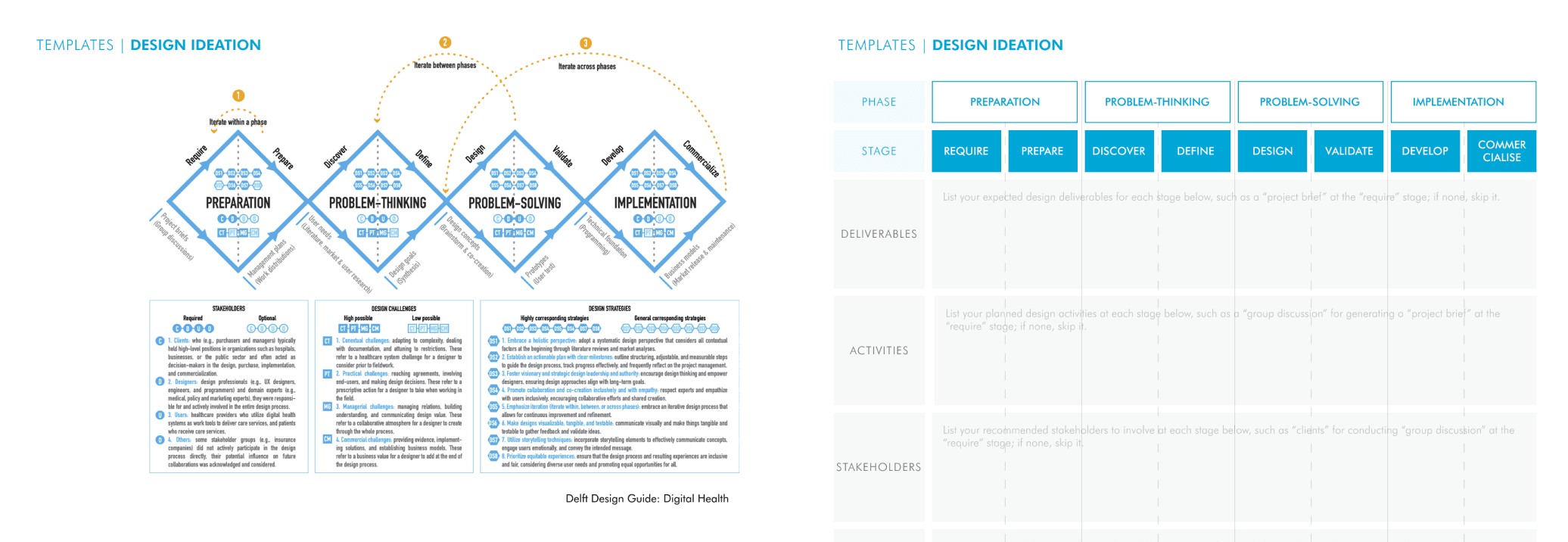How to improve
digital patient experience?
Our processes determine the quality of our products", as Dubberly stated. A design process can be considered a rational process with defined phases that guide designers towards achieving specific goals at each phase. While design processes across different domains seem similar at an abstract level, their emphasis on specific activities often varies significantly between domains. Healthcare itself is significantly conflicted, complex, and adaptive and is highly regulated and constrained. Besides, digital health is often utilized by multiple user groups, such as patients and healthcare providers, in various healthcare settings, from preventing to diagnosing to treating diseases. Designing for digital health is challenging. To better manage the whole design process and play a critical role in recognizing, prioritizing, and acting on stakeholders’ needs while also facilitating interdisciplinary collaborations between disciplines, thorough preparation by understanding the general digital health design process, challenges, and strategies is necessary for digital health designers.
part 3
Design Ideation
Designers often engage in various collaborative activities with multiple stakeholders and disciplines throughout the entire digital health design process to improve the patient experience. Knowing the general digital health design process, identifying potential design challenges, and equipping yourself with related design strategies can help to improve the digital patient experience smoothly. In this section, we provide you with a digital health design framework comprising four design phases and eight stages. Each phase depicts typical deliverables and design activities, presents the required stakeholders and possible design challenges, and summarizes eight adaptable strategies to address these challenges. After this section, you are expected to be familiar with creating an appropriate design process management plan to guide your design process.
Phase 1. Preparation
Stakeholders
C
D
U
O
Design Challenges
CT
PT
MG
CM
Design Strategies
DS1
DS2
DS3
DS4
DS5
DS6
DS7
DS8
1.1
CLARIFYING PROJECT REQUIREMENTS
Receiving the design task from internal or external clients often marks the beginning of a DH design project: "First, meet your clients; they will say what they would like to achieve." The inception of a DH design project can range from a vague design intuition (e.g., “a thought from daily life”) to a broad design vision (e.g., “improve the PEx”), or it can be a specific design brief (e.g., “design a digital patient sheet”). It often follows a typical design process (e.g., “double diamond ”). Design requirements (e.g., “design context”), resources (e.g., “investment ”), and briefs (e.g., “project purposes”) are typically clarified early on, considering public sector regulations and stakeholder interests and resources.
1.2
CREATING A PROJECT PLAN
A plan gives stakeholders a comprehensive understanding of project complexity and provides a dialogue that breaks down divisions: “project management is your best friend” and it “needs to be looking at everything”. Initially, this stage was infrequently mentioned by the participants in their workflows. However, on reflection on past projects, many acknowledged the need for “good project management ”, “a person who has the vision”, “more structured and continuous inputs” from varied stakeholders, “making a holistic plan”, and “knowing about how the process was going to be” from the beginning, if they were to run the project again. “A time plan is an important factor for managing the design process better”. During this stage, typical tasks include building the team, managing time, allocating assignments, determining methodology, and setting milestones.
TEMPLATE
Create your digital health design plan

